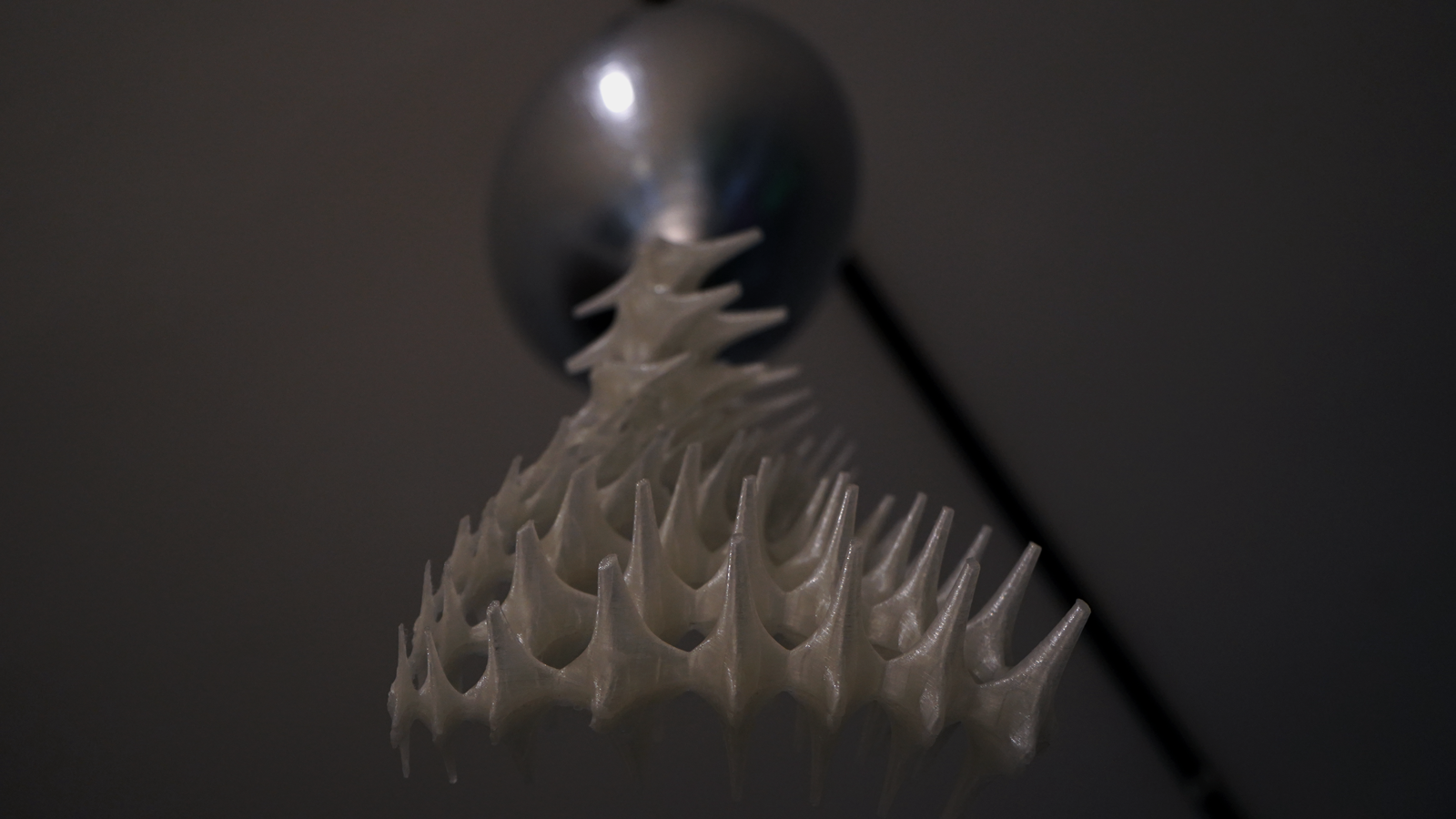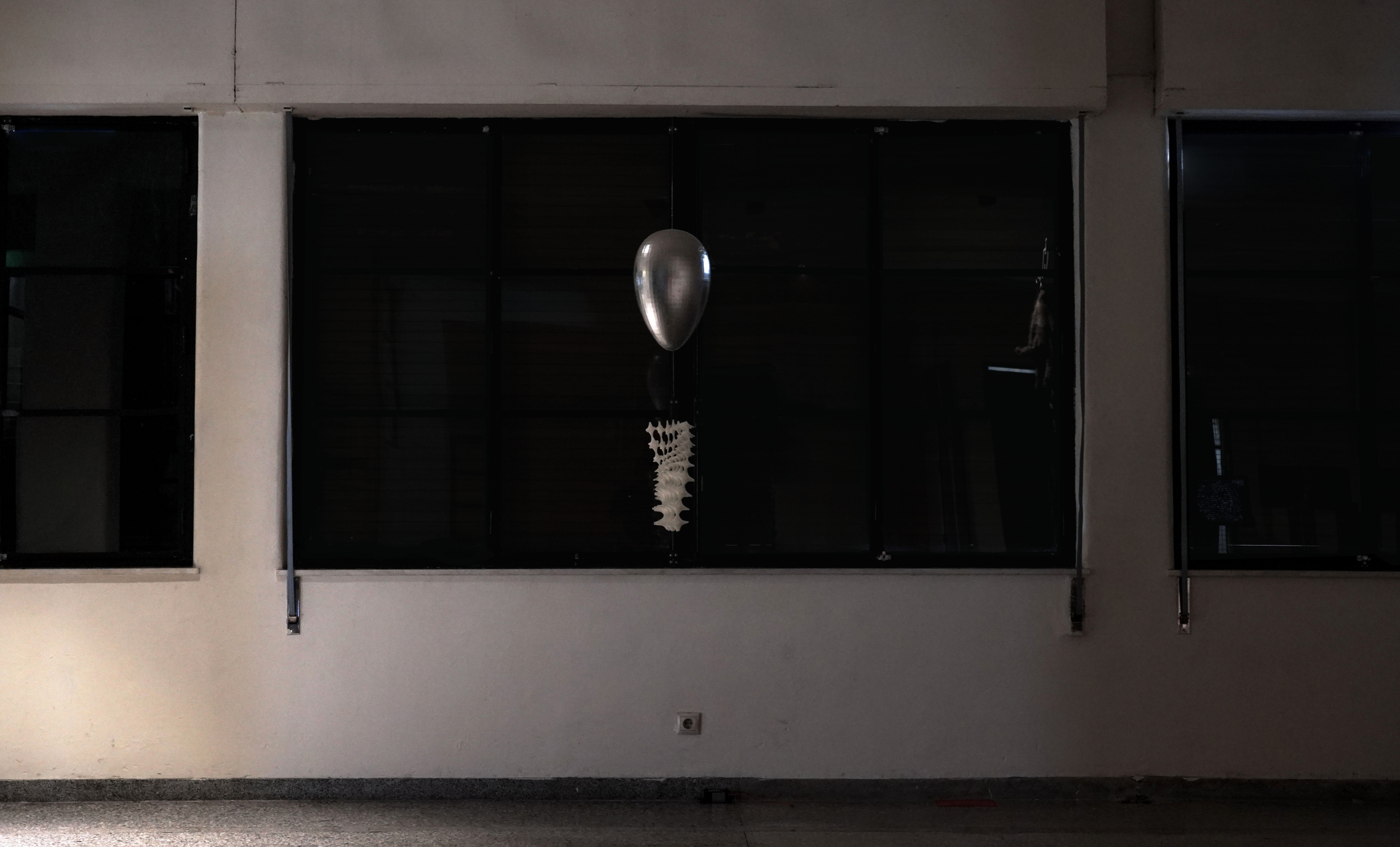Maria Paneta
Modular Bones™
 On the verge of the post-anthropocene we have reached the limits of our own body and we fathom the necessity of expanding ourselves in a sensory and bodily context. Modular Bones™ is dealing with the issue of human extinction and life in non habitable places in two parts: a Living Strategy of human life facing extinction towards the post-anthropocene and The Kun, a system of wearables designed to preserve human intelligence along with the human body.The installation consists of two 3d printed sculptures, an automated reading of Sarah Teasdale's work 'There will come soft rains', an AR app of the augmented post-anthropocene self and a short film.
On the verge of the post-anthropocene we have reached the limits of our own body and we fathom the necessity of expanding ourselves in a sensory and bodily context. Modular Bones™ is dealing with the issue of human extinction and life in non habitable places in two parts: a Living Strategy of human life facing extinction towards the post-anthropocene and The Kun, a system of wearables designed to preserve human intelligence along with the human body.The installation consists of two 3d printed sculptures, an automated reading of Sarah Teasdale's work 'There will come soft rains', an AR app of the augmented post-anthropocene self and a short film. Modular Bones™: Living strategies
There will come soft rains
There will come soft rains and the smell of the ground,
And swallows circling with their shimmering sound;
And frogs in the pools singing at night,
And wild plum trees in tremulous white;
Robins will wear their feathery fire
Whistling their whims on a low fence-wire;
And not one will know of the war, not one
Will care at last when it is done.
Not one would mind, neither bird nor tree
If mankind perished utterly;
And Spring herself, when she woke at dawn,
Would scarcely know that we were gone.
Sara Teasdale, 1918

Life towards the end of humanity on Earth is portrayed in Teasdale’s words. Although extinction is inevitable, humans have emerged as hybrids in non-human territories occupying the Earth and neighbouring planets. Modular Bones™ are sensory augmentation and body enhancement tools exploring new age intimacy. They are prosthetic packages enabling and extending human life. Sensory augmentation of the human body is achieved by user-specific data collection. Body enhancement is allowed by artificial prosthetic growth based on 3D-printed mass production.
They are a study on intelligent prosthetic agents developed to serve the demand for endurance, connection and intimacy. This study investigates how these agents are reproduced and what are the networks of care they formulate. Modular Bones™ is a speculative experiment of the impact of prosthetics driven by unfamiliar spatial demands. It is a means of documentation of the potential social controversies the use of prosthetics may spark off.
Modular Bones™ is an intelligent self-developing system that emerges as a number of practices and symbiotic methods. Artificial intelligence and self-developing systems that support living, could potentially define an overlapping living system calling for self-sufficiency. On the larger scheme of things, this symbiosis could expand in a broader system as a mode of unified living between species, overcoming interspecies hierarchy (Haraway 2016).
Bodies are to be adjusted to live in unfamiliar grounds connecting thought prosthetic agents of endurance, intimacy and care. Habitability hasn’t been more relative, bodies haven’t been more adjustable and their interaction is yet to be discovered.
Towards the augmented body: The Kun
One of these methods is Kun, a self-organised system able to undergo morphogenesis and organismal growth. Kun is a prosthetic part made from bone, tissue and sensors. It attaches to the body-to-be-augmented and serves as a functional body part.
Kun is a time-varying living prosthetic entity that is self-adaptive using feedback signals from its surrounding interface. Kun is a metabolically active entity composed of living tissue structures mainly of the skeletal and dermal systems. Kun encompasses sensors and foreign polymer material structures and can execute haptic and biomechanical tasks. It may exhibit dimensional fluctuations partially dictated by its supply and partially by its surrounding environment as a reconfigurable organism (Kriegman, 2020). The morphological structure of Kun allows it to remain in an alternating cross-talk between the wearer and the atmosphere. Kun adjusts its functionality according to the user’s locomotory needs and modifies its properties.
In the post-anthropocene Kun allows the exploration of ‘yet to be experienced’ environments transmitting signals to itself, the wearer but also to the cloud (AI). Kun is semi-autonomous and can self-regulate its function, however interaction with its wearer is crucial (relies on nutritional supplementation from its wearer). This sets the boundaries and limits the autonomy of its functionality. Some may term Kun as a living soft-robot (Appiah et al., 2019) however its haptic capabilities and memory (dynamically evolving data-bank) might qualify it as a conscious-less organism with data transferring function. The augmented organism that results through the operation of Kun is composed of the wearer, the wearable and information that is exchanged between other Kun devices and wearers resulting in a super-organism (Wilson, 2012).
www.mariapaneta.com/
Collaborators
Scientific curation: Yiannis Papantoniou
Sound design: NatCase
Maria Paneta is a multidisciplinary designer and practicing architect working between London and Athens. She has exhibited internationally with shows at MoCa Shanghai, Texas, London and Athens. She has worked with leading cultural and research institutions including the Bartlett School of Architecture and the Victoria & Albert Museum London, where she
taught interaction design.Graduated from Interactive Architecture Lab in 2016, she is working on the verge of art and architecture with an interest in cybernetics, interaction and cognition.
Her study in the Bartlett resulted in the development of the wearable ‘Sarotis’, a prosthetic device that augments spatial awareness and creates tactile virtual spaces. ‘Sarotis’ questions how soft prosthetic devices can modify the user’s spatial awareness and mitigate the distance between bodies, minds and space. She creates virtual spaces dealing with the augmented life in non-human environments.